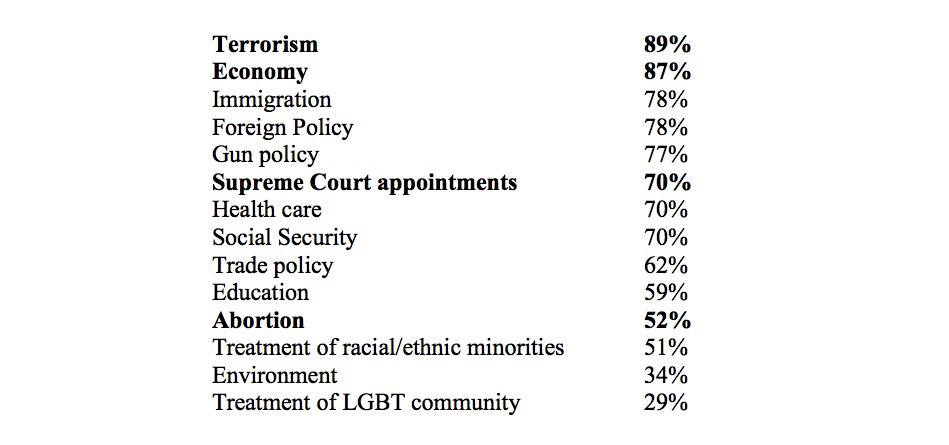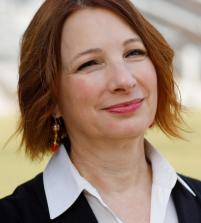
Myths Debunked: Why Did White Evangelical Christians Vote for Trump?
What motivated white evangelicals to vote for Trump in 2016: Abortion and supreme-court nominees? No. Terrorism, the economy, and immigration.
Why did a record 81% of white evangelicals vote for Donald Trump in the recent presidential election? A common explanation in the media is that these voters wanted to safeguard the empty seat on the Supreme Court with the hope of overturning Roe v. Wade. Though widely accepted, there are at least two problems with this explanation.
First, while abortion rights have been a consistent preoccupation (for conservatives and progressives alike), white evangelical support for Republican presidential candidates has been inconsistent. Pew Research data shows that 78% of white evangelicals voted for George W. Bush in 2004, 74% for John McCain in 2008, and 78% for Mitt Romney in 2012. Ballots cast for Trump hit a new high.
Second, despite the claims of pundits who speak on their behalf—pastors and other religious leaders—the abortion issue was not a primary concern for white evangelicals in this election. When, in November 2016, a LifeWay Research poll asked white evangelicals what one issue they considered most important when voting, only 10% said “Supreme Court nominees,” and a mere 4% said “abortion.” In contrast, 20% of pastors said “Supreme Court nominees,” and 10% said “abortion.”

In total, nearly half of white evangelicals considered the economy or national security most important when choosing between presidential candidates. Even when the Pew Research Center asked them which issues—not limited to a single one—were “very important” to them in deciding how to cast their votes, terrorism (89%) and the economy (87%) ranked higher than Supreme Court appointments (70%) and abortion (52%).

For many white evangelical voters, then, worries about the Supreme Court and Roe v. Wade were not primary factors. Simply put, the amped-up obsession with the Supreme Court and Roe v. Wade in the media points to an opinion gap between the people in the pews and their clergy.
Why this disconnect? Reporters may not be aware that some white evangelical pastors hold different views than the lay people whom they supposedly represent. Also religious leaders may themselves not be aware that their views differ from those of their congregants. Regardless of the reasons, when Franklin Graham, President of the Billy Graham Evangelistic Association, told NBC that “This election is about the Supreme Court and the justices that the next president will nominate,” he was not speaking for all white evangelicals. Neither was Richard Land, President of Southern Evangelical Seminary, who, NBC reported, “believes evangelicals were motivated to vote in unprecedented numbers because of Hillary Clinton’s record on abortion.”
Contra Graham and Land, the unprecedented numbers of white evangelicals who voted for Trump were principally motivated by worries about the economy. This may seem odd. Scratch the surface of the U.S. economy and all appears to be well. According to Bureau of Labor Statistics data released in late 2016, the number of private sector jobs has grown for 80 consecutive months, 178,000 people were added to payrolls in November, and the unemployment rate dropped to 4.6%. Wage growth, though slower, was still running ahead of inflation, and consumers were expressing the highest levels of confidence in nearly a decade.
Still more confounding, based on data alone, is the fact that white Trump supporters—white evangelicals among them—are somewhat better off than other Americans, including other whites. According to Nate Silver the median household income for Trump’s non-Hispanic white supporters was about $72,000, or $10,000 higher than that of all non-Hispanic whites.
Nonetheless, many white evangelicals are, or see themselves as, left behind financially.
To understand why this is the case requires a closer look at the median household income since the Great Recession of 2007-2008. Six years into the economic recovery, the U.S. Census Bureau reported that incomes in the middle range—when adjusted for inflation—were still 1.6% below the previous 2007 peak of $57,423 per household. Also problematic, these incomes remained 2.4% lower than the high reached during the late 1990s. Most of the registered income gains have bypassed middle-income workers, like the average white evangelical Trump voter, and gone to those at the top of the income ladder. Seen in the broad context of the past few decades, the average wage earner has failed to get ahead. Though more people are back at work, the New York Times’s Binyamin Applebaum wrote, “many of them are still struggling to maintain their standard of living.”
Patricia Cohen, also writing for the New York Times, echoed these grim assessments. Despite recent good news about the economy, she said, “tens of millions of Americans understandably feel that the recovery has passed them by.” Many without skills are stuck with low-paying jobs plagued by irregular and unreliable schedules and by little or no security or benefits. Others, laid off from the well-compensated manufacturing jobs that left the U.S. for other countries, have had to accept lower-wage positions, if they found work at all.
Eric Hoffer, in his classic book The True Believer, described what he called the “new poor.” He found that the intensity of the discontent found among the new poor is not necessarily tied to economic hardship. Indeed, individuals born into misery do not usually revolt against the status quo—their lot is bearable because it is familiar and predictable. Discontent, the emotion Trump tapped into so adeptly, is more likely to afflict people who have experienced prosperity. When their comfortable life is diminished in some way, the result is intolerable. According to Hoffer, it is usually “those whose poverty is relatively recent, the ‘new poor,’ who throb with the ferment of frustration. The memory of better things is as fire in their veins.”
Actual financial struggles, along with the memory of better things, may explain why more white evangelicals voted for the Republican candidate than in previous elections. It may also explain why worries about the economy took precedence over distaste for Trump as a person. Surveys showed that many white evangelicals objected to Trump’s sexism, racism, anti-Muslim-ism, anti-immigrant-ism, and other ugly-isms. Barna Group found that 49% of white evangelicals felt that Trump lacked a strong moral character. Only 15% saw him as “authentically Christian.”
Still, Trump successfully tapped into their economic anxiety—justified or not—with his slogan: “Make American Great Again.” Hillary Clinton, with her insistence that America was already great, probably appeared horribly out of touch. Trump, in contrast, agreed with the new poor that the nation’s economy was in trouble. He promised seemingly quick fixes like eliminating trade agreements that appeared to favor foreign companies over American ones, forcing U.S.-based companies to keep jobs stateside instead of shipping them overseas, and reducing competition for jobs with a tough stance toward illegal immigrants. In his first press conference as President-elect last week, Trump pledged to be “the greatest jobs producer that God ever created.”
Why bother to try to understand the motivations of white evangelical voters? Because, according to Pew surveys, they make up 26% of the American electorate, giving them significant political clout. (That percentage has held since 2008.) Of course, white evangelicals do not constitute a single voting bloc. They cover the spectrum of political affiliations. But the fact that more than four out of five placed their trust in Trump deserves attention.
Trump paid attention to the power of this group and assembled an evangelical advisory council to assist his campaign. Going forward, future campaigns would do well to do the same. Most importantly, though, rather than relying on the opinions of pastors and religious leaders, or on economic reports that fail to take the larger picture into account, those who wish to succeed in understanding and responding to the concerns of white evangelicals ought to reach out to them directly.
Resources
- Appelbaum, Binyamin. “Fed Raises Key Interest Rate, Citing Strengthening Economy.” The New York Times. December 14, 2016.
- Casselman, Ben. “Inequality Is Killing The American Dream.” FiveThirtyEight. December 8, 2016.
- Cohen, Patricia. “President Obama Is Handing a Strong Economy to His Successor.” The New York Times. December 2, 2016.
- Edsall, Thomas B. “Trump Voters Are Feeling It.” The New York Times. December 8, 2016.
- Glueck, Katie. “Trump’s religious dealmaking pays dividends.” POLITICO. December 7, 2016.
- Graham, Franklin. Facebook page. October 14, 2016.
- Hoffer, Eric. The True Believer: Thoughts on the Nature of Mass Movements. Harper Perennial Modern Classics, 2010.
- Johnson, Alex. “What’s Behind Evangelical Support for Donald Trump? Less Than You Think.” NBC News. October 16, 2016.
- Khazan, Olga. “Why Christians Overwhelmingly Backed Trump.” The Atlantic. November 9, 2016.
- Kuruvilla, Carol. “After Trump’s Win, White Evangelical Christians Face A Reckoning.” The Huffington Post. November 9, 2016.
- Porter, Eduardo. “America’s Inequality Problem: Real Income Gains Are Brief and Hard to Find.” The New York Times. September 13, 2016.
- Silver, Nate. “The Mythology of Trump’s ‘Working Class’ Support.” FiveThirtyEight. May 3, 2016.
- Smith, Gregory A., and Jessica Martínez. “How the faithful voted: A preliminary 2016 analysis.” Pew Research Center. November 9, 2016.
- Wojcik, Natalie, Mack Hogan, and Mike Juang. “Transcript of President-elect Trump’s news conference.” CNBC. January 11, 2017.
- Zylstra, Sarah Eekhoff, and Jeremy Weber. “Top 10 Stats Explaining the Evangelical Vote for Trump or Clinton.” Christianity Today. November 4, 2016.
Image: Franklin Graham at the Nebraska State Capitol Building in Lincoln, Nebraska, during his "Decision America 2016" tour | Photo credit: Cornstalker via Wikimedia Commons (cc)
Sightings is edited by Brett Colasacco, a PhD candidate in Religion, Literature, and Visual Culture at the University of Chicago Divinity School. Click here to subscribe to Sightings as a twice-weekly email. You can also follow us on Twitter.


